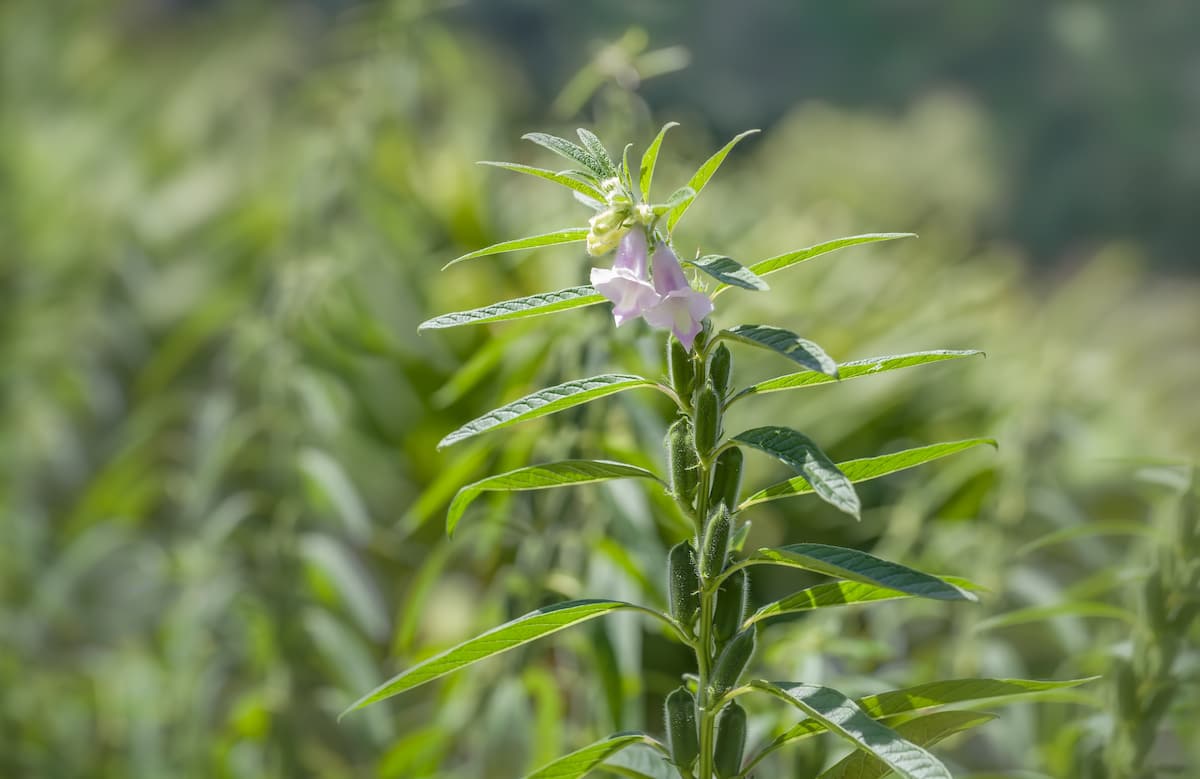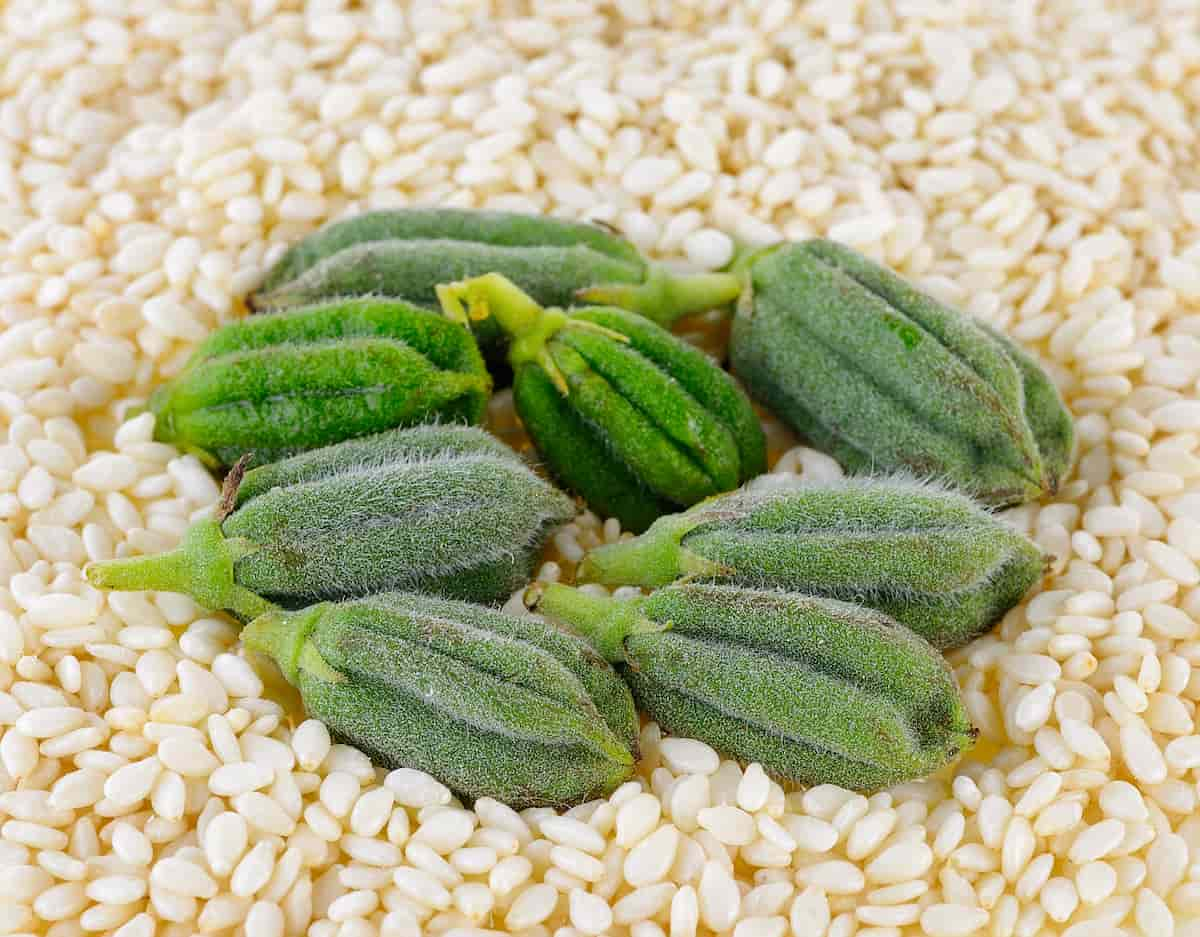Sesame is an annual plant with an erect and branched growth habit, capable of reaching a height of 1.5 to 2 meters. It displays significant variation in size, shape, the color of flowers, and seed size and composition. The crop is drought-tolerant and thrives in warm seasons. The seeds, which are the economic part of the plant, are ovate, slightly flattened, and thinner at the hilum than the opposite end.

Depending on the variety, a thousand seeds can be small, medium, or large, with an average weight of 2 to 4 g. Bakeries consume sesame seeds whole, while oil extraction involves pressing them. Light-colored seeds yield superior oil quality than dark ones.
Sesame Production Guide
Best Package and Practices of High-Production Sesame
To achieve high sesame production, following best practices such as planting in well-draining soil, providing adequate water, and fertilizing with balanced nutrients is crucial. Timely weeding and disease control are also necessary. Proper post-harvest handling and storage are essential to maintain seed quality.
Land/ Field Preparation and Soil Requirements for Sesame
Sesame can thrive in various soils, but well-drained light to medium-textured soils are preferred, with an optimum pH range of 5.5 to 8.0. The soil should be plowed 2-4 times and broken into a fine tilth before broadcasting the seeds evenly. Mixing seeds with sand, dry soil, or well-sieved manure in a 1:20 ratio facilitates easy seeding and even distribution. Plowing and pressing with a wooden plank should cover the seed in the soil.
Temperature, Climatic, and Rainfall Requirements for Sesame
Sesame is a crop that can be cultivated in almost all states, with areas ranging from small to large. It can grow to an altitude of 1600m, with the optimum temperature during its life cycle ranging between 25-35 degrees Celsius. Hot winds and temperatures exceeding 40 degrees Celsius can reduce the oil content, during temperatures below 15 degrees Celsius or beyond 45 degrees Celsius result in severe yield reduction. The crop is grown during Kharif in arid and semi-arid regions and during rabi/summer in cooler areas, with an annual rainfall of 625-1100mm.
Propagation Method and Seed Quality for Sesame
Sesame is propagated through seeds, which should be of high quality, uniform size, weight, and viability, and free from diseases and pests.
Seed Treatment for Sesame
Seed treatment with three packets of Azospirillum (600g/ha) and three packets of Phosphobacteria or six packets of Azophos (1200g/ha) can substitute 25% of the nitrogen in sesame cultivation. Ten packets of Azospirillum and Phosphobacteria (2000g/ha) can be used instead for better results.
Seed Rate and Spacing for Sesame
A seed rate of 5kg/ha is recommended for sesame cultivation. The spacing between rows and plants should be 30cm each. In rice fallows, the seeds are broadcasted, and the plants are thinned to maintain 11 plants per square meter.
In case you missed it: Castor Production Guide: A Step-By-Step Cultivation Practices

Sowing Method for Sesame
For best results, sesame seeds should be sown in rows. The seeds can be mixed with dry sand in a 1:4 ratio and dropped evenly along the furrows where fertilizers have been applied. The recommended sowing depth is 3cm, followed by covering with soil. Under summer irrigated conditions, the optimum time for sowing VRI (SV) 1 sesame is the second fortnight of February to the first fortnight of March.
Crop Rotation and Intercropping in Sesame
Sesame needs ample sunlight for optimal photosynthesis, making it suitable for intercropping with short-stemmed grain crops. It is also an excellent choice for crop rotation. In lowland areas, it can be planted after crops such as sorghum, cotton, peanuts, soybeans, onions, and other vegetables without any issues. It is planting sesame after these crops have increased cotton, sorghum, soybeans, and millet yields.
Manure & Fertilizer Applications in Sesame
- Spread 12.5 t/ha of FYM or compost before plowing.
- For rainfed or irrigated sesame, apply recommended doses of NPK or use Azospirillum and Phosphobacteria/Azophos.
- Apply a full dose of NPK, add Manganese sulfate, and apply 50% of recommended P 2O 5 and K 2O with the full recommended dose of N for irrigated gingelly—place fertilizer mix in furrows or broadcast evenly on beds before sowing.
Weed Management and Herbicide Application in Sesame
Weed the field twice, 15-20 days and 30-35 days after sowing. Thin the crop to achieve 15-25 cm spacing between plants when they reach 15 cm in height.
Water Management in Sesame
Sesame is typically rainfed, but irrigating at critical stages can increase yield by 35-52%. Two 3cm deep irrigations during vegetative and reproductive phases are best for maximum yield and water use efficiency. Single irrigation in the reproductive phase is also effective. In water-scarce areas, irrigating tail-end fields can increase sesame production.
Disease Control in Sesame
Phyllody, Dry root rot, and Phytophthora blight are three diseases commonly affecting sesame plants. Phyllody causes green leafy structures to replace floral parts, leading to witch broom-like appearance. Dry root rot makes young seedlings water-soaked, while older ones have elongated brownish-black lesions.
Phytophthora blight causes water-soaked spots on leaves and stems, leading to chestnut brown lesions and premature leaf fall. Alternaria blight causes dark brown water-soaked lesions, possibly leading to defoliation or death. These diseases survive in the soil, seed, or leaf hopper, with high humidity and soil moisture favoring their development.
Pest Control in Sesame
The sesame leafhopper damages plants by sucking sap, causing leaf curling, browning, and dropping. Seed treatment with imidacloprid or thiamethoxam and spraying neem seed kernel extract or other insecticides can manage the pest. The hawk moth defoliates plants, and deep plowing, collecting, and destroying caterpillars can control them. For the Bihar hairy caterpillar, collecting and destroying infested plant parts, installing bird perches and light traps, and using Bacillus thuringiensis var. kurstaki, neem seed kernels extract, or other insecticides can be effective.
Harvesting and Threshing of Sesame
Harvest sesame plants in the morning when leaves turn yellow and droop; the bottom capsules are lemon yellow. Pull out the plants and stack them in bundles for 3-4 days until the leaves fall off. Spread them in the sun and use sticks to break open the capsules for three days. Preserve the first day’s seeds for sowing, and clean and dry them in the sun for seven days before storing them.
Sesame Yield per Acre
One acre of sesame field can yield approximately 4-5 quintals of sesame for the farmer.
In case you missed it: Pea Production Guide: A Step-By-Step Cultivation Practices

Conclusion
Sesame cultivation requires careful land preparation, sowing, irrigation, and pest management. Proper fertilization, weed control, and timely harvesting and processing of sesame plants are also critical for a successful harvest.
- Feed Your Flock for Less: Top 10 Tips to Save on Chicken Feed
- Ultimate Guide to Ossabaw Island Hog: Breeding, Raising, Diet, and Care
- Hatching Answers: The Top 10 Reasons Your Chickens Aren’t Laying Eggs
- Eggs and Economics: Breaking Down the Cost of Raising Backyard Chickens
- Defend Your Greens: Proven Methods to Keep Iguanas Out of Your Garden
- Ultimate Guide to Cinnamon Queen Chicken: A Comprehensive Guide for Beginners
- Ultimate Guide to California Tan Chicken: Breeding, Raising, Diet, Egg-Production and Care
- Ultimate Guide to Marsh Daisy Chicken: Breeding, Raising, Diet, and Care
- 10 Types of Chicken Farming Businesses You Can Start for Profits